You know, I still haven’t met a single learner that has not struggled with the Spanish preterite tense at one point or another. I’m not saying this to discourage you. In fact, the preterite (also spelled as preterit) is not nearly as bad as you think it is.
Is it an important past tense? Heck, yes! You’ll need it if you want to talk about past actions. For this reason, in this guide, I’ll focus on providing you with crucial information about the preterite tense in Spanish.
Here’s what you’ll learn through this article:
- Conjugations: How to Form the Preterite
- Uses of the Spanish Preterite
- Words that Trigger the Preterite
- When to Use Imperfect or Preterite
- Key Points
Preterite Tense Conjugations
The preterite endings for regular verbs are:
| Subject | -AR verbs | -ER & -IR verbs |
|---|---|---|
| Yo | -é | -í |
| Tú | -aste | -iste |
| Él / Ella / Usted | -ó | -ió |
| Nosotros | -amos | -imos |
| Vosotros | -asteis | -isteis |
| Ellos / Ellas / Ustedes | -aron | -ieron |
So, all you have to do is add these endings to the verb stem. Check the preterite form of comprar, comer and vivir.
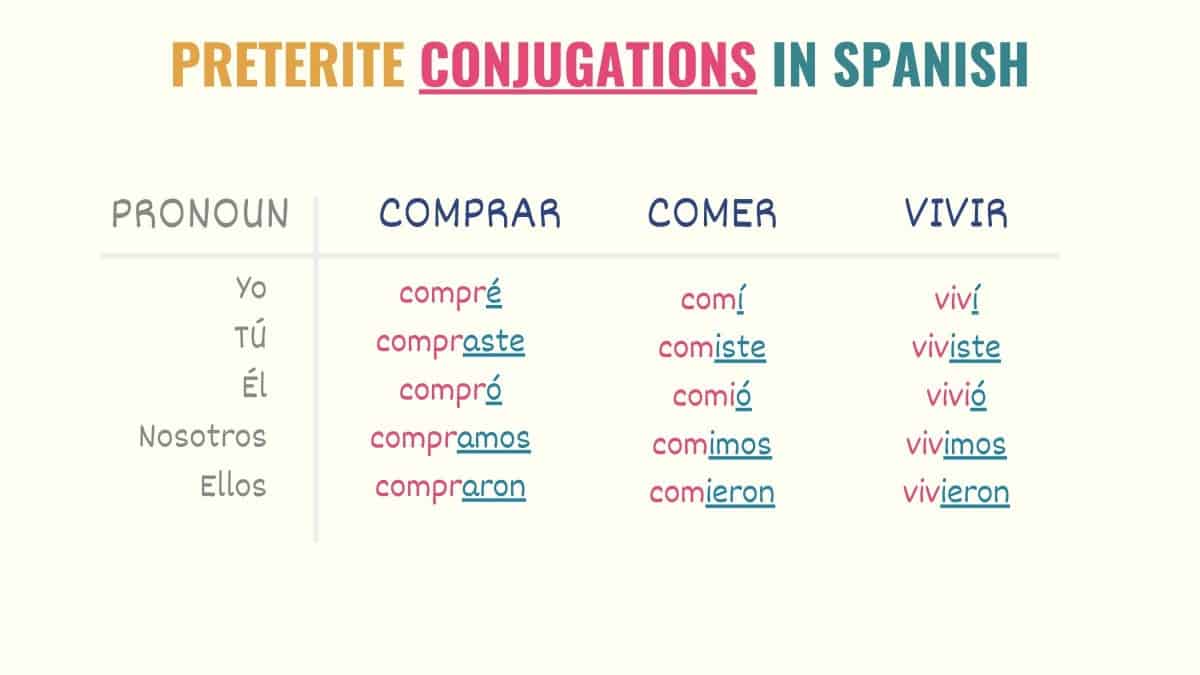
As you may already know, the present tense has many stem-changing verbs in Spanish. Verbs with spelling changes in the present tense will also have changes in the preterite tense.
Here are the verbs and the subject pronouns you need to watch out for:
- First person singular (yo)
- Verbs that end in ‘-car’, ‘-gar’, ‘-zar’.
- Third person singular and plural
- Stem changing -IR verbs
- Verbs that result in triphthongs (leer, construir, oír, huir, caer)
You can see the changes you have to make in the graphic below:
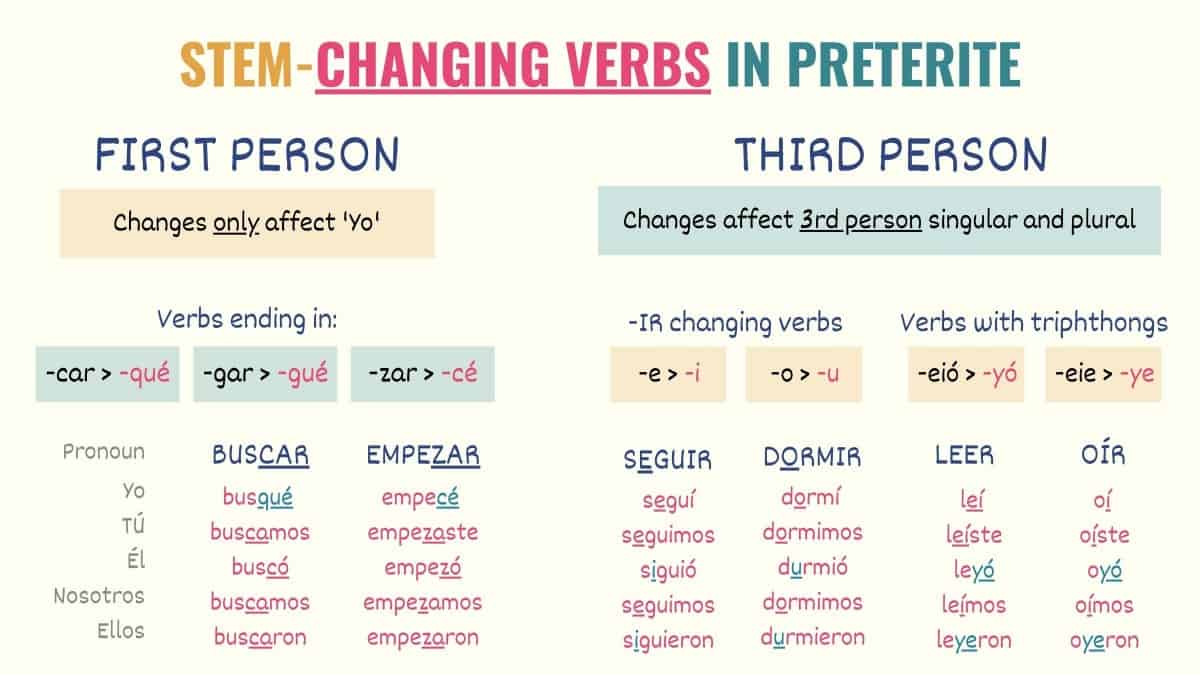
Below are some examples with the verbs vestirse, tocar, llegar and leer.
[Verb preterite] + [complement]
Yo me vestí y me fui.
I dressed and left.
Leah se vistió después de bañarse.
Leah dressed after she showered.
Yo llegué a la una de la tarde.
I arrived at one in the afternoon.
Los chicos llegaron tarde.
The boys arrived late.
Ellas tocaron la puerta.
They knocked on the door.
Yo no te toqué.
I didn’t touch you.
¿Ya leíste el libro?
Did you already read the book?
Oigan, ¿ya leyeron el libro?
Hey, guys, did you already read the book?
Take Note: Accent marks are key for the Spanish preterite conjugations. In writing situations, you only need to add the proper accent mark. However, when it comes to speaking, make sure to adjust your pronunciation. Check the examples below.
Yo canto.
I sing.
Él cantó.
He sang.
Irregular verbs in the preterite tense
Unlike the imperfect tense in Spanish, the preterite has many irregular verbs. These irregular verbs have significant changes on their stems and they also use slightly different endings.
With the exception of ser and ir, the endings for irregular verbs are:
| Subject | Irregular ending |
|---|---|
| Yo | -e |
| Tú | -iste |
| Él / Ella / Usted | -o |
| Nosotros | -imos |
| Vosotros | -isteis |
| Ellos / Ellas / Ustedes | -ieron |
Irregular endings do not have an accent mark. Can you tell why? Because the irregularities of these verbs are more than enough to indicate that they are in the preterite form.
Here are some patterns of irregular verbs in the Spanish preterite tense.
Verbs with ‘uv’ in the stem
- Estar – Estuv
- Andar – Anduv
- Tener – Tuv
Verbs with ‘u’ in the stem
- Saber – Sup
- Poder – Pud
- Poner – Pus
- Caber – Cup
- Haber – Hub
Verbs with ‘i’ in the stem
- Hacer – Hic
- Venir – Vin
- Querer – Quis
- Decir – Dij
Derivatives of ‘traer’ and verbs with a ‘-ducir’ suffix
- Conducir – Conduj
- Traducir – Traduj
- Producir – Produj
- Traer – Traj
- Atraer – Atraj
So to conjugate these verbs, you can follow this formula:
[Irregular stem] + [irregular ending]
¿Qué hicieron el sábado?
What did you guys do on Saturday?
Lo siento, tuve mucho trabajo.
I’m sorry, I had a lot of work.
Nosotros estuvimos enfermos.
We were sick.
No supe qué hacer.
I didn’t know what to do.
Ayer te pusiste esa camisa.
You wore that t-shirt yesterday.
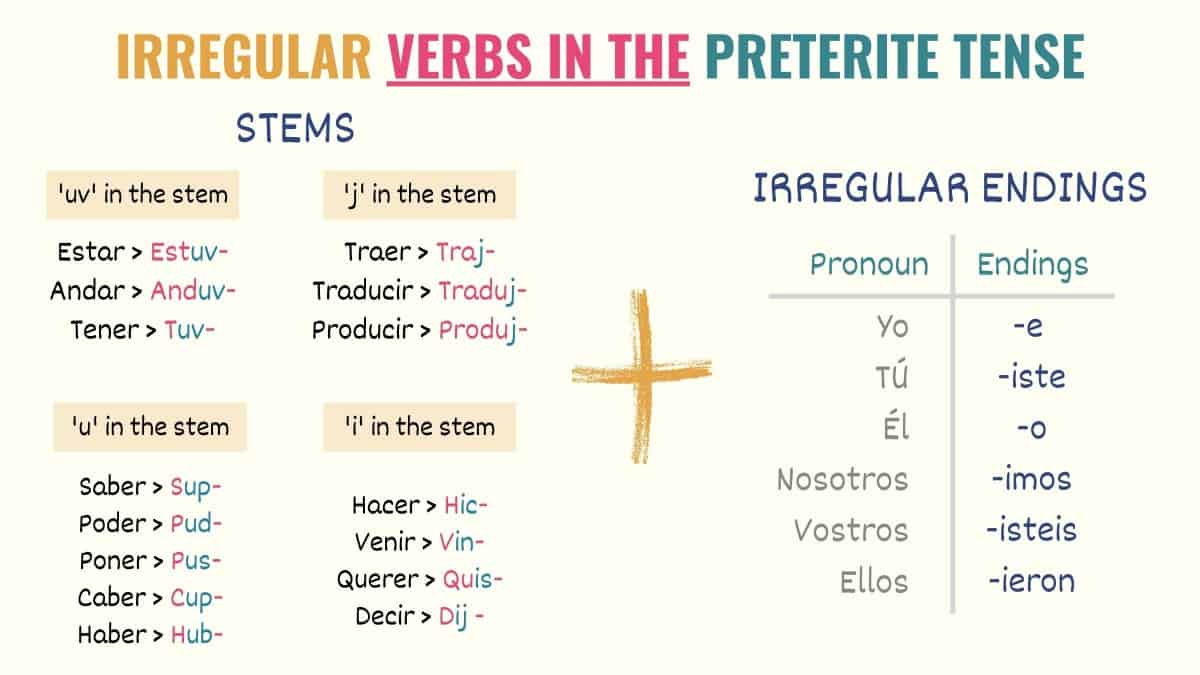
Ser and ir are also irregular verbs. In fact, in the preterite tense, these verbs have the same conjugation. The context can help you tell which verb is being used.
| Person | Ser | Ir |
|---|---|---|
| Yo | fui | fui |
| Tú | fuiste | fuiste |
| Él / Ella / Usted | fue | fue |
| Nosotros | fuimos | fuimos |
| Vosotros | fuisteis | fuisteis |
| Ellos / Ellas / Ustedes | fueron | fueron |
Helen fue al cine.
Helen went to the movies.
Louise fue la mejor maestra que tuve.
Louise was the best teacher I ever had.
Take Note: Since they have the same conjugation, it can be hard to tell if we’re referring to ser or ir. However, unlike ‘ser’, ir is always followed by the preposition ‘a’ (to). This can be an easy and quick way to tell which verb is being used.
When to Use the Spanish Preterite
As a Spanish past tense, the preterite refers to past actions and events. However, this tense conveys that those actions ended or were completed at some point in the past.
We use the preterite in Spanish to talk about:
- Actions that were completed in the past.
- Actions that began or lasted a specific period of time in the past.
- Sequence of events or actions completed in the past.
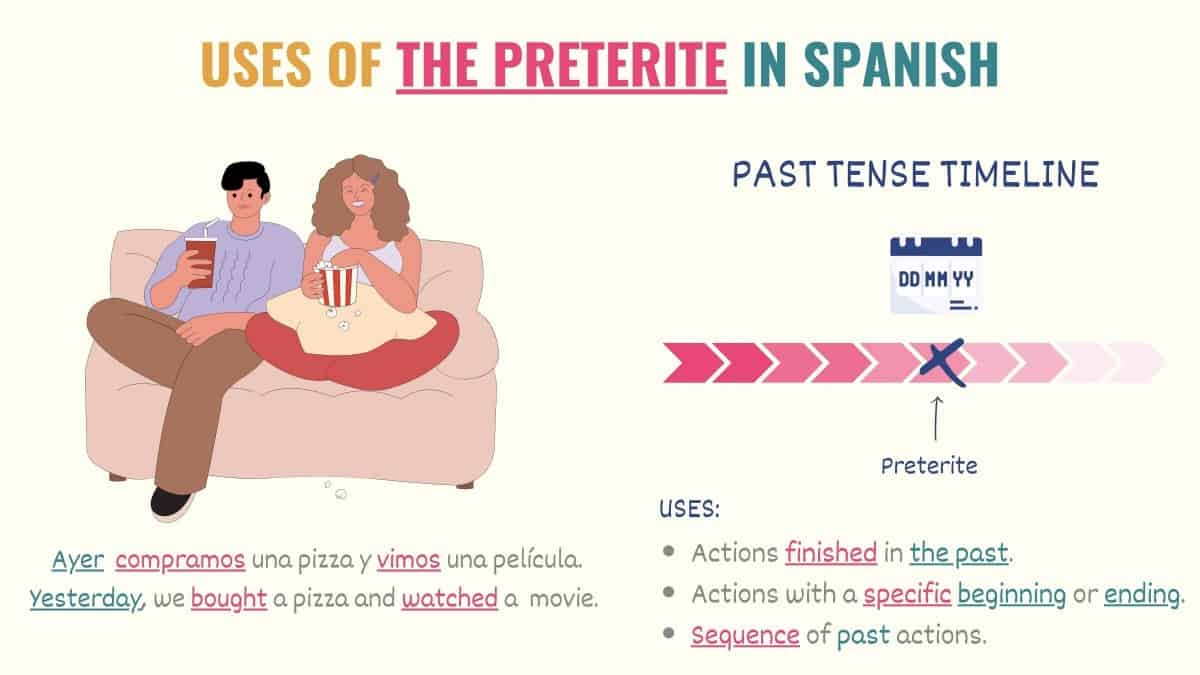
Sentences in the preterite tense
Below I’ve provided examples to clarify and illustrate each of these uses for the preterite tense in Spanish and various situations in which you can use them.
Actions completed in the past
(Subject pronoun) + [Verb in the preterite]
Hoy no desayuné.
I didn’t have breakfast today.
Charlie compró un coche nuevo.
Charlie bought a new car.
Ellos limpiaron su cuarto.
They cleaned their room.
¿Supiste que Greg y Pam se casaron?
Did you know that Greg and Pam got married?
Actions that occurred or began at a specific point in the past or lasted a specific amount of time
(Subject pronoun) + [Verb in the preterite]
Empecé a trabajar la semana pasada.
I started working last week.
Mis hermanas nacieron en abril.
My sisters were born in April.
Eleanor vivió en Barcelona durante tres años.
Eleanor lived in Barcelona for three years.
En 1950, mi abuela conoció a mi abuelo.
My grandmother met my grandfather in 1950.
Sequence of actions completed in the past
(Subject pronoun) + [Verb in the preterite] + [verb in the preterite]
Ya lavé y sequé los platos.
I already washed and dried the dishes.
Mis vecinas pintaron y remodelaron su casa.
My neighbors painted and renovated their house.
Juan se levantó, desayunó y se fue a trabajar.
Juan woke up, ate breakfast and went to work.
Take Note: In Spanish, ‘desayunar’ is a verb used to say ‘to eat breakfast’, which is why we don’t need to explicitly use ‘comer’.
Trigger Words for Preterite
Here is a table with some common time markers that work with the preterite tense:
| Spanish | English |
|---|---|
| Ya | Already |
| Ayer | Yesterday |
| El año pasado* | Last year |
| Hace* | Ago |
| Anoche | Last night |
| Hoy | Today |
| Esta mañana | This morning |
| En ese momento | In that moment |
| Una vez* | One time |
| En 1950* | In 1950 |
| La semana pasada | Last week |
| El 8 de julio* | On July 8 |
| El otro día | The other day |
Some notes about these triggering words:
- You can replace ‘año’ with months and days. Just make sure the article matches the gender of the noun you use.
- ‘Hace’ needs to be followed by an amount of time.
- ‘Una vez’ is a singular form. You can change the number in Spanish to say how many times an action happened (e.g. dos veces, tres veces, etc).
- All dates in Spanish are trigger words for the preterite.
Keep in mind that trigger words are a great help, but they’re not mandatory. Additionally, since Spanish is so flexible, they can be placed before or after the verb in preterite.
La semana pasada vi a Claudia.
I saw Claudia last week.
Lauren renunció hace tres años.
Lauren quit three years ago.
Hoy no fuimos a la oficina.
We didn’t go to the office today.
Take Note: Just like in English, hoy (today) can be a trigger word for the preterite tense. This is because some actions you did today are already finished. However, this use is more popular in Latin American Spanish. In Spain, you would use hoy with the present perfect tense.
How to Tell When to Use Preterite or Imperfect in Spanish
The imperfect tense in Spanish is another past tense. This leads to a common question– how do you know if you have to use preterite or imperfect?
Before I give you the explanation, check the examples below.
Tip: don’t focus on the translation because it’s likely to be the same for both examples. Instead, focus on the Spanish sentences and check all the elements surrounding the verb. If you need help, jump to the graphic below.
Cuando era niña, jugaba con mis hermanos.
When I was a kid, I played with my brothers.
Ayer jugué con mi hermanito.
Yesterday I played with my little brother.
Do you see the difference?
We use imperfect tense to describe actions that we did frequently in the past. These can be habits or events that took place so often that we cannot tell the specific moment when they happened or how many times they happened.
Put another way to help you remember this rule, if we can’t perfectly point out a moment in time when the event or action took place, then it must be imperfect.
That’s the idea I’m delivering with example #1. Playing with my brothers was something I did frequently, so I cannot tell you a date or how many times we played together.
On the contrary, the preterite in Spanish is way more specific. It tells you exactly when I played with my brother and it also implies how many times I did this action…at least just for yesterday! I’m a better sister than that!
Hopefully, this graphic helps you see this distinction:
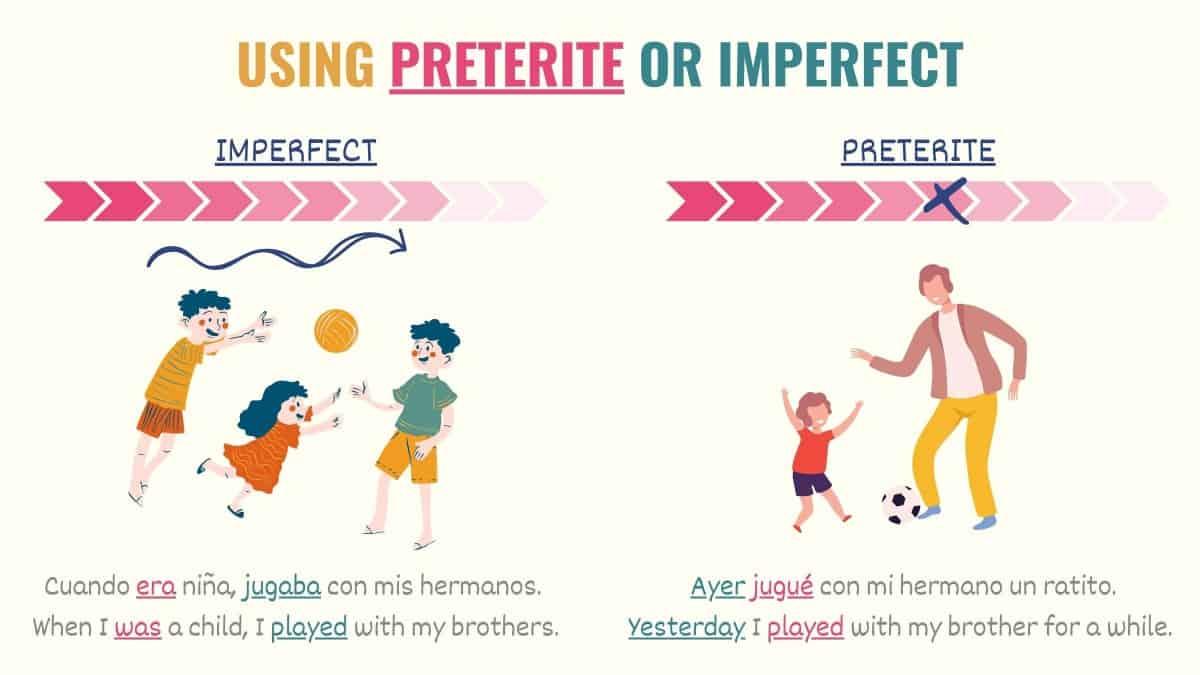
Key Points
When talking about the past, the Spanish preterite refers to complete past actions. Here are some rules and key points that you need to keep in mind:
- We use the preterite tense to refer to:
- Actions that have a clear ending or beginning.
- A sequence of past actions.
- Actions that were clearly finished in the past.
- Some -IR stem changing verbs in the present tense also have spelling changes in the preterite. This change only affects the third person singular and plural.
- Verbs ending in -car, -gar and -zar have a consonant change when being conjugated to the first person singular.
- Irregular verbs in the preterite tense have major changes in their stem and their endings are slightly different from regular verbs.
- Trigger words for the preterite tense refer to a specific moment in time.
We Spanish speakers also learn the preterite in school. But, why don’t we struggle with this tense like many Spanish learners do? Because we use it all the time by speaking the language! So, to master the preterite, you need to practice a lot! You can start by taking this conjugation preterite quiz.



